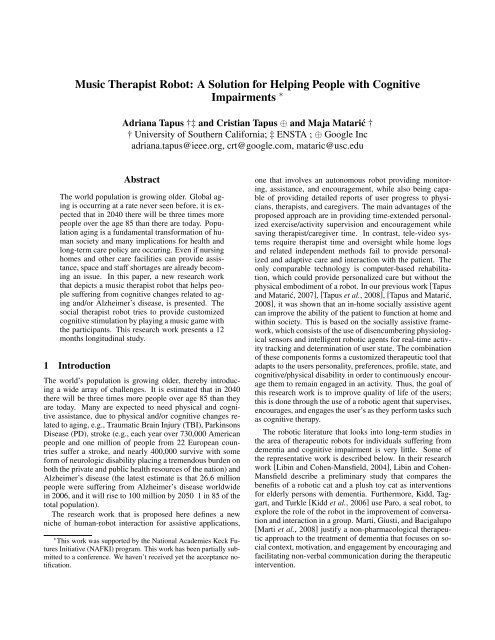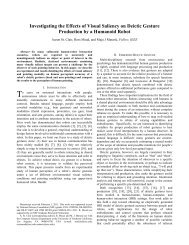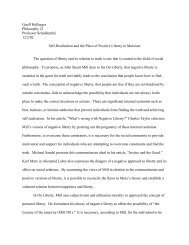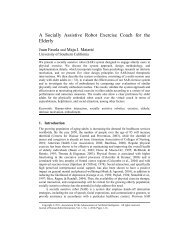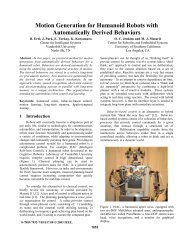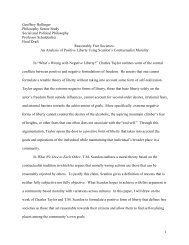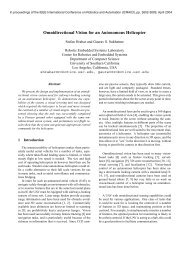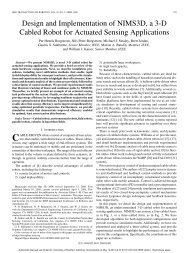Music Therapist Robot: A Solution for Helping People with Cognitive ...
Music Therapist Robot: A Solution for Helping People with Cognitive ...
Music Therapist Robot: A Solution for Helping People with Cognitive ...
Create successful ePaper yourself
Turn your PDF publications into a flip-book with our unique Google optimized e-Paper software.
<strong>Music</strong> <strong>Therapist</strong> <strong>Robot</strong>: A <strong>Solution</strong> <strong>for</strong> <strong>Helping</strong> <strong>People</strong> <strong>with</strong> <strong>Cognitive</strong>Impairments ∗Adriana Tapus †‡ and Cristian Tapus ⊕ and Maja Matarić †† University of Southern Cali<strong>for</strong>nia; ‡ ENSTA ; ⊕ Google Incadriana.tapus@ieee.org, crt@google.com, mataric@usc.eduAbstractThe world population is growing older. Global agingis occurring at a rate never seen be<strong>for</strong>e, it is expectedthat in 2040 there will be three times morepeople over the age 85 than there are today. Populationaging is a fundamental trans<strong>for</strong>mation of humansociety and many implications <strong>for</strong> health andlong-term care policy are occuring. Even if nursinghomes and other care facilities can provide assistance,space and staff shortages are already becomingan issue. In this paper, a new research workthat depicts a music therapist robot that helps peoplesuffering from cognitive changes related to agingand/or Alzheimer’s disease, is presented. Thesocial therapist robot tries to provide customizedcognitive stimulation by playing a music game <strong>with</strong>the participants. This research work presents a 12months longitudinal study.1 IntroductionThe world’s population is growing older, thereby introducinga wide array of challenges. It is estimated that in 2040there will be three times more people over age 85 than theyare today. Many are expected to need physical and cognitiveassistance, due to physical and/or cognitive changes relatedto aging, e.g., Traumatic Brain Injury (TBI), ParkinsonsDisease (PD), stroke (e.g., each year over 730,000 Americanpeople and one million of people from 22 European countriessuffer a stroke, and nearly 400,000 survive <strong>with</strong> some<strong>for</strong>m of neurologic disability placing a tremendous burden onboth the private and public health resources of the nation) andAlzheimer’s disease (the latest estimate is that 26.6 millionpeople were suffering from Alzheimer’s disease worldwidein 2006, and it will rise to 100 million by 2050 1 in 85 of thetotal population).The research work that is proposed here defines a newniche of human-robot interaction <strong>for</strong> assistive applications,∗ This work was supported by the National Academies Keck FuturesInitiative (NAFKI) program. This work has been partially submittedto a conference. We haven’t received yet the acceptance notification.one that involves an autonomous robot providing monitoring,assistance, and encouragement, while also being capableof providing detailed reports of user progress to physicians,therapists, and caregivers. The main advantages of theproposed approach are in providing time-extended personalizedexercise/activity supervision and encouragement whilesaving therapist/caregiver time. In contrast, tele-video systemsrequire therapist time and oversight while home logsand related independent methods fail to provide personalizedand adaptive care and interaction <strong>with</strong> the patient. Theonly comparable technology is computer-based rehabilitation,which could provide personalized care but <strong>with</strong>out thephysical embodiment of a robot. In our previous work [Tapusand Matarić, 2007], [Tapus et al., 2008], [Tapus and Matarić,2008], it was shown that an in-home socially assistive agentcan improve the ability of the patient to function at home and<strong>with</strong>in society. This is based on the socially assistive framework,which consists of the use of disencumbering physiologicalsensors and intelligent robotic agents <strong>for</strong> real-time activitytracking and determination of user state. The combinationof these components <strong>for</strong>ms a customized therapeutic tool thatadapts to the users personality, preferences, profile, state, andcognitive/physical disability in order to continuously encouragethem to remain engaged in an activity. Thus, the goal ofthis research work is to improve quality of life of the users;this is done through the use of a robotic agent that supervises,encourages, and engages the user’s as they per<strong>for</strong>m tasks suchas cognitive therapy.The robotic literature that looks into long-term studies inthe area of therapeutic robots <strong>for</strong> individuals suffering fromdementia and cognitive impairment is very little. Some ofthe representative work is described below. In their researchwork [Libin and Cohen-Mansfield, 2004], Libin and Cohen-Mansfield describe a preliminary study that compares thebenefits of a robotic cat and a plush toy cat as interventions<strong>for</strong> elderly persons <strong>with</strong> dementia. Furthermore, Kidd, Taggart,and Turkle [Kidd et al., 2006] use Paro, a seal robot, toexplore the role of the robot in the improvement of conversationand interaction in a group. Marti, Giusti, and Bacigalupo[Marti et al., 2008] justify a non-pharmacological therapeuticapproach to the treatment of dementia that focuses on socialcontext, motivation, and engagement by encouraging andfacilitating non-verbal communication during the therapeuticintervention.
The work presented in this paper focuses on the study ofthe social, interactive, and adaptive aspects of robot behaviorin an assistive context designed <strong>for</strong> the elderly and/or individualssuffering from dementia. This study aims to address thefollowing research questions:• Can elderly individuals <strong>with</strong> dementia and/or cognitiveimpairments maintain attention to music <strong>with</strong> the help ofa robot in an intervention specifically designed to promoteactive listening?• How do their responses and per<strong>for</strong>mance compares toresponses and per<strong>for</strong>mances of well-elderly and elderlythat have not participated in the study?• What are short-term effects of attention training <strong>with</strong> elderlywho are suffering from dementia and/or other cognitiveimpairments?• Will the music-based cognitive game <strong>with</strong> the robothelp the elderly individuals <strong>with</strong> dementia and/or cognitiveimpairments increase their “positive behavior” (e.g.,smiling, speaking, and participating in group activities)?2 HypothesesThis work tests the following two hypotheses:Hypothesis 1: The social robot can help to improve and/ormaintain the cognitive attention of individuals <strong>with</strong> dementiaand/or cognitive impairments through its encouragementsin a specific music-based cognitive game. Active listeningprovides a potential method <strong>for</strong> engaging cognitive skills ofindividuals <strong>with</strong> Alzheimer’s and/or dementia.Hypothesis 2: The robot can adapt its behavior (based onthe user’s disability level) to improve the user’s task per<strong>for</strong>mancein the cognitive game.3 <strong>Robot</strong>ic Plat<strong>for</strong>mThe experimental testbed is a humanoid torso mounted on amobile plat<strong>for</strong>m (Figure 1). The mobile plat<strong>for</strong>m is an Activ-Media Pioneer 2DX robot equipped <strong>with</strong> a speaker, a SonyPan-Tilt-Zoom (PTZ) color camera, and a SICK LMS200eye-safe laser range finder. The biomimetic anthropomorphicsetup involves a humanoid Bandit II torso, consisting of 22controllable degrees of freedom, which include: 6 DOF arms(x2), 1 DOF gripping hands (x2), 2 DOF pan/tilt neck, 2 DOFpan/tilt waist, 1 DOF expressive eyebrows, and a 3 DOF expressivemouth. All actuators are servos allowing <strong>for</strong> gradualcontrol of the physical and facial expressions.We are particularly interested in utilizing the humanoid’santhropomorphic but not highly realistic appearance as ameans of establishing user engagement, and comparing itsimpact to our prior work <strong>with</strong> non-biomimetic robot test-beds[Tapus and Matarić, 2007], [Tapus et al., 2008].4 Experimental DesignThe experiment consists of repeated sessions, during whichthe user and the robot interact in the context of a cognitivegame. The first session is the orientation, in which the participantis ‘introduced’ to the robot. The robot is brought intothe room <strong>with</strong> the participant, but is not powered on. DuringFigure 1: <strong>Robot</strong> test-bed: Bandit II humanoid torso mountedon the Pioneer mobile baseFigure 2: <strong>Cognitive</strong> Game: Name That Tunethis introduction period, the experimenter or the participant’snurse/physical/music therapist explains the robot’s behavior,the overall goals and plans of the study, and what to expectin future sessions. The participant is also asked about his/herfavorite songs from a variety popular tunes from the appropriatetime period; those songs are later used in the subsequentsessions. At the end of the session, the Standardized Mini-Mental State Examination (SMMSE) cognitive test is administeredso as to determine the participant’s level of cognitiveimpairment and the stage of dementia. This test provides in<strong>for</strong>mationabout the cognitive (e.g., memory recall) level ofimpairment of the participant <strong>for</strong> use in initializing the gamechallenge level. The data determine the participant’s initialmental state and level of cognitive impairment, and serve as apre-test <strong>for</strong> subsequent end-of-study comparison <strong>with</strong> a posttest.This experiment is designed to improve the participant’slevel of attention and consists of a cognitive game called SongDiscovery or Name That Tune. The participant is asked tofind the right button <strong>for</strong> the song, press it, say the name ofthe song, and sing along. The criteria <strong>for</strong> participation in theexperiment (in addition to the Alzheimer’s or dementia diagnosis)include the ability to read large print and to press abutton. The participant stands (see sketch Figure 3a) or sits(see Figure 3b) in front of a vertical experimental board <strong>with</strong>5 large buttons (e.g., the Staples EASY buttons - see Figure2). Four buttons correspond to the different song excerpts(chosen as a function of the user’s preference) and the lastbutton corresponds to the SILENCE or no song excerpt condition.Under each button, a label <strong>with</strong> the name of the song(or SILENCE) is printed.The robot describes to each participant the goal of the gamebe<strong>for</strong>e each session, based on the following transcript: “We
(a)Figure 4: Adaptation System(b)Figure 3: Human-<strong>Robot</strong> Interaction <strong>Cognitive</strong> Game Setup:(a) standing position; or (b) sitting positionwill play a new music game. In it, we will play a music collectionof 4 songs. The songs are separated by silence. Youwill have to listen to the music and push the button correspondingto the name of the song being played. Press the buttonmarked “SILENCE” during the silence period betweenthe songs. The robot will encourage you to find the correctsong.”Each participant is first asked by the music therapist or therobot to read aloud the titles of the songs and to press a button.Some additional directions are given. The participant is alsodirected to press the SILENCE button when there is no musicplaying. After a review of the directions, the participant isasked by the robot to begin the music game. The music compilationis composed of a random set of song excerpts out ofthe four different songs that <strong>for</strong>m the selection and the silencecondition. The entire music compilation lasts between 10 and20 minutes, and is based on the user’s level of cognitive impairment:the larger the impairment, the shorter the session.A song excerpt can be vocal, instrumental, or both. The orderof song excerpts is random.The experiment was repeated once per week <strong>for</strong> a period of12 months in order to capture longer-term effects of the robottherapist. A <strong>with</strong>in-subject comparison was per<strong>for</strong>med totrack any improvement over multiple sessions. No betweensubjectanalysis was done due to the small sample size andlarge differences in cognitive ability levels.5 <strong>Robot</strong> Learning and Behavior AdaptationThe learning and robot behaviour adaptation methodologywas designed <strong>for</strong> the interaction between the robot and peoplesuffering of dementia and/or Alzheimer’s disease, <strong>with</strong> themain goal of helping these individuals to improve or maintaintheir cognitive attention through encouragements in a specificmusic based cognitive stimulation game.This approach consists of two parts: supervised learningand adaptation. The robot models the following interactionparameters:• Level of game challenge presented by therobot/computer:– No hint (difficult level);– When the song excerpt starts say “push the button”but do not indicate which button to push (mediumlevel);– When the song excerpt starts say which button topush (easy level)..The supervised learning system learns <strong>for</strong> each game leveland <strong>for</strong> each disability bucket (mild, moderate, and severe)an Accepted Variation Band (AVB) as a function of users’task per<strong>for</strong>mance to the cognitive game and the correctnessof their answers. The learning phase is followed by an adaptationphase where the robot adapts its behavior so as to minimizereaction time and maximize user correct answers.If the user’s task per<strong>for</strong>mance is below the Accepted VariationBand, this indicates that the user is per<strong>for</strong>ming better thanduring the learning phase and results in promoting the user tothe higher the game difficulty level. In contrast, if the user’stask per<strong>for</strong>mance is above the Accepted Variation Band, thisindicates that the user is not per<strong>for</strong>ming well enough and thegame difficulty level is decreased, as shown in Figure 4.6 Experimental ResultsThe initial pilot experimental group consisted of 9 participants(4 male, 5 female), from our partner Silverado SeniorLiving care facility. All the participants were seniorsover 70 years old suffering of cognitive impairment and/orAlzheimer’s disease. The cognitive scores assessed by theSMMSE test were as follows: 1 mild, 1 moderate, and 7 severe.Due to the total unresponsiveness of 6 of the severeparticipants, only 1 severely cognitively disabled participantwas retained <strong>for</strong> the rest of the study, resulting in a final groupcomposed of 3 participants (3 female).
Figure 5: Human-User interacting <strong>with</strong> the robot during the actual music game: the robot is giving hints related to the musicgame, the user answers, and the robot congratulates and applauses the correct answer of the userFigure 6: Game Level Adaptation and Evolution Over Time(6 months) <strong>for</strong> User Id 1We constructed the training data and built a model <strong>for</strong> eachcognitive disability level and <strong>for</strong> each game level. The participantsplayed each game level 10 times (stages) in order toconstruct a robust training corpus.The results obtained over 6 months of robot interaction(excluding the 2 months of learning) suggest that the elderlypeople suffering of dementia and/or Alzheimer’s can sustainattention to music across a long period of time (i.e., on average20 minutes <strong>for</strong> mildly impaired participants, 14 minutes<strong>for</strong> moderately impaired participants, and 10 minutes <strong>for</strong>severely impaired participants) of listening activity designed<strong>for</strong> the dementia and/or Alzheimer’s population. Figures 6,7, and 8 illustrate the evolution of the game difficulty overtime, as well as response incorrectness and reaction time <strong>for</strong>user id 1.Outcomes are quantified by evaluating task per<strong>for</strong>manceand time on task. Based on the results to date, it can be con-Figure 7: Incorrectness Evolution Over Time (6 months) <strong>for</strong>User Id 1
time.This study is ongoing; two more weeks of active experimentation<strong>with</strong> the current group of participants are neededto complete the results. Once the study is complete, we willper<strong>for</strong>m an SMMSE post-test and look <strong>for</strong> any possible differencesfrom the pre-test. We will also collect feedback fromthe facility’s music therapist (via a Likert-type questionnaire)about the participants’ attentional and cognitive responses inthe music attention settings. Finally, caregivers will also beasked about the improvements and the possibility of transferof knowledge (interactive <strong>for</strong>mat <strong>with</strong> the patients, familymembers, and the robot). More details will be available bythe time of the workshop.Figure 8: Reaction Time Evolution Over Time (6 months) <strong>for</strong>User Id 1cluded that the SAR system was able to adapt the challengelevel of the game it was presenting to the user in order to encouragetask improvement and attention training. Figure 6shows the evolution in time of the game level <strong>for</strong> user id 1.The participant started at the easy game level and remainedthere <strong>for</strong> several sessions. The participant then started to per<strong>for</strong>mbetter and diminished the reaction time and reduced thenumber of incorrect answers, which, in turn, resulted in agame level evolution from the easy level to difficult. Startingfrom the 22nd trial, the participant consistently remainedat the highest level of difficulty in the game (see Figure 5).Figures 7 and 8 depict the evolution of the reaction time andthe number of incorrect answers. The decrease of those metricsindicates improvement on the task. Similar improvementwas observed <strong>for</strong> all participants.The participants recognized the songs and identified the silenceperiods <strong>with</strong> the same probability. Hence, the analysisof the “no answer” situation among our elderly participantsprovides us <strong>with</strong> additional in<strong>for</strong>mation. From our experiments,we noticed that the average rate of absence of responseto silence was higher than the average rate of absence of responseto songs, and that this phenomenon increased <strong>with</strong> theseverity of the cognitive impairment. Our conjecture is thatmusic stimulates the interest and responsiveness of the patients.Another interesting observation that deserves more studyis the users’ ability to participate simultaneously in differenttasks (multitasking): the participants were able to sing andpush the correct buttons at the same time. This is notablein particular <strong>for</strong> participants <strong>with</strong> cognitive disability, sincemultitasking requires dividing attention.The results obtained to date support our theory. First, oursocial robot was able to improve or maintain the cognitive attentionof the patients <strong>with</strong> dementia and/or cognitive impairmentsthrough its encouragements in a specific music-basedcognitive game. Second, the robot’s capability of adapting itsbehavior to the individuals’ level of disability helped to improvethe user’s task per<strong>for</strong>mance in the cognitive game over7 ConclusionsThis research aims to develop a socially assistive therapistrobot that can provide through long-term learning customizedcognitive stimulation <strong>for</strong> individuals suffering from dementiaand/or other cognitive impairment. The main goal of therobot is to improve through the social interaction their cognitiveabilities and there<strong>for</strong>e their quality of life. This modelinvolves user engagement through speech and gesture. Thepreliminary results already show promise <strong>for</strong> our approach.AcknowledgmentsWe are also grateful to our partner: Silverado Senior Living -The Huntington, Alhambra, CA, USA. Many thanks to VidaGwinn (Facility Administrator), Cheryl Stollman (ActivitiesProgram Director), Jessi Nunez and Zena Buccola (ActivitiesAssistants), Rudy Medina (Plant Operations Supervisor),Tamara Mitchel (Administrator Assistant), and all the personnel<strong>for</strong> all their help and their support.References[Kidd et al., 2006] C. Kidd, W. Taggart, and S. Turkle. Asociable robot to encourage social interaction among theelderly. In IEEE International Conference on <strong>Robot</strong>ics andAutomation (ICRA), Orlando, USA, May 2006.[Libin and Cohen-Mansfield, 2004] A. Libin and J. Cohen-Mansfield. Therapeutic robocat <strong>for</strong> nursing home residents<strong>with</strong> dementia: Preliminary inquiry. Am J Alzheimers DisOther Demen, 19(2):111–116, 2004.[Marti et al., 2008] P. Marti, L. Giusti, and M. Bacigalupo.Dialogues beyond words. Interaction Studies, 2008.[Tapus and Matarić, 2007] A. Tapus and M. J. Matarić. Emulatingempathy in socially assistive robotics. In Proceedingsof the American Association of Artificial Intelligence(AAAI) Spring Symposium on - Multidisciplinary Collaboration<strong>for</strong> Socially Assistive <strong>Robot</strong>ics, Palo Alto,USA,2007.[Tapus and Matarić, 2008] A. Tapus and M. J. Matarić. Sociallyassistive robotic music therapist <strong>for</strong> maintaining attentionof older adults <strong>with</strong> cognitive impairments. InProceedings of AAAI Fall Symposium AI in Eldercare:New <strong>Solution</strong>s to Old Problem, Washington D.C., USA,November 2008.
[Tapus et al., 2008] A. Tapus, C. Tapus, and Maja J Matarić.User-robot personality matching and robot behavior adaptation<strong>for</strong> post-stroke rehabilitation therapy. IntelligentService <strong>Robot</strong>ics, 1(2):169–183, April 2008.


